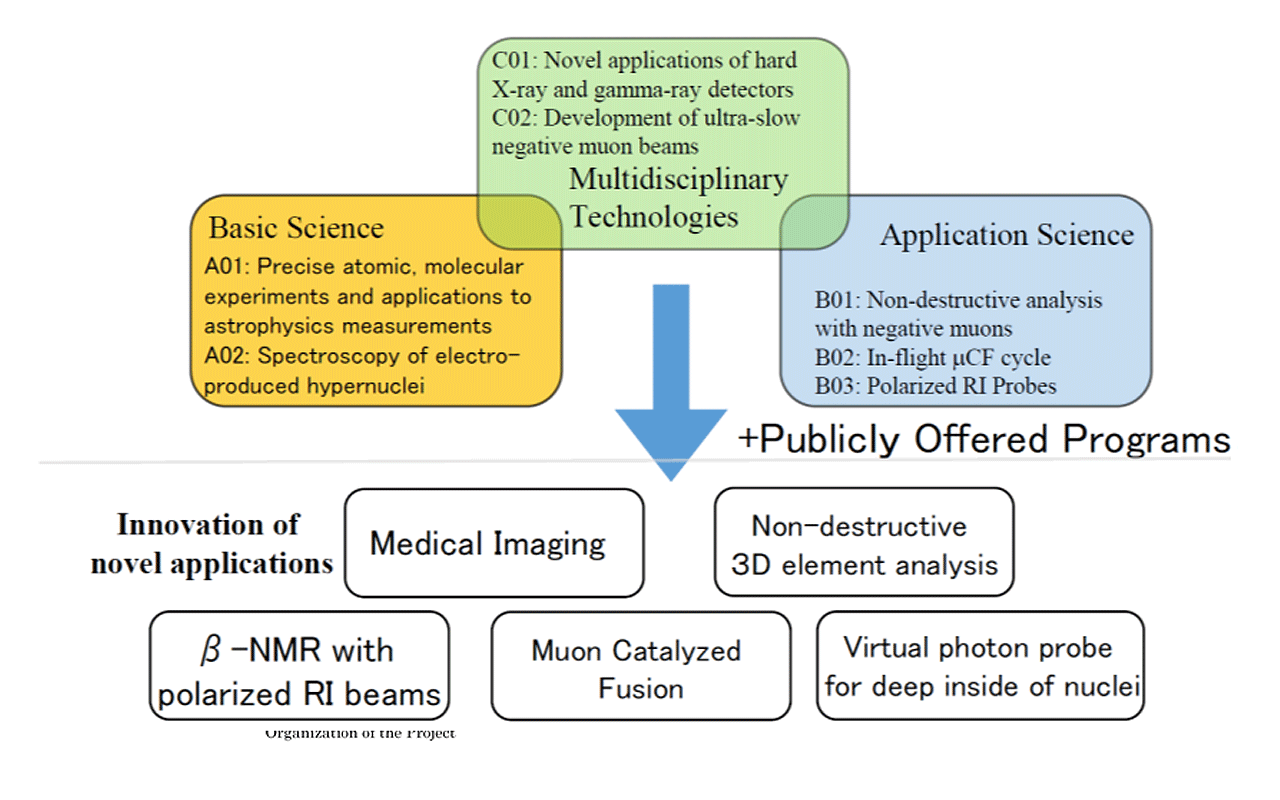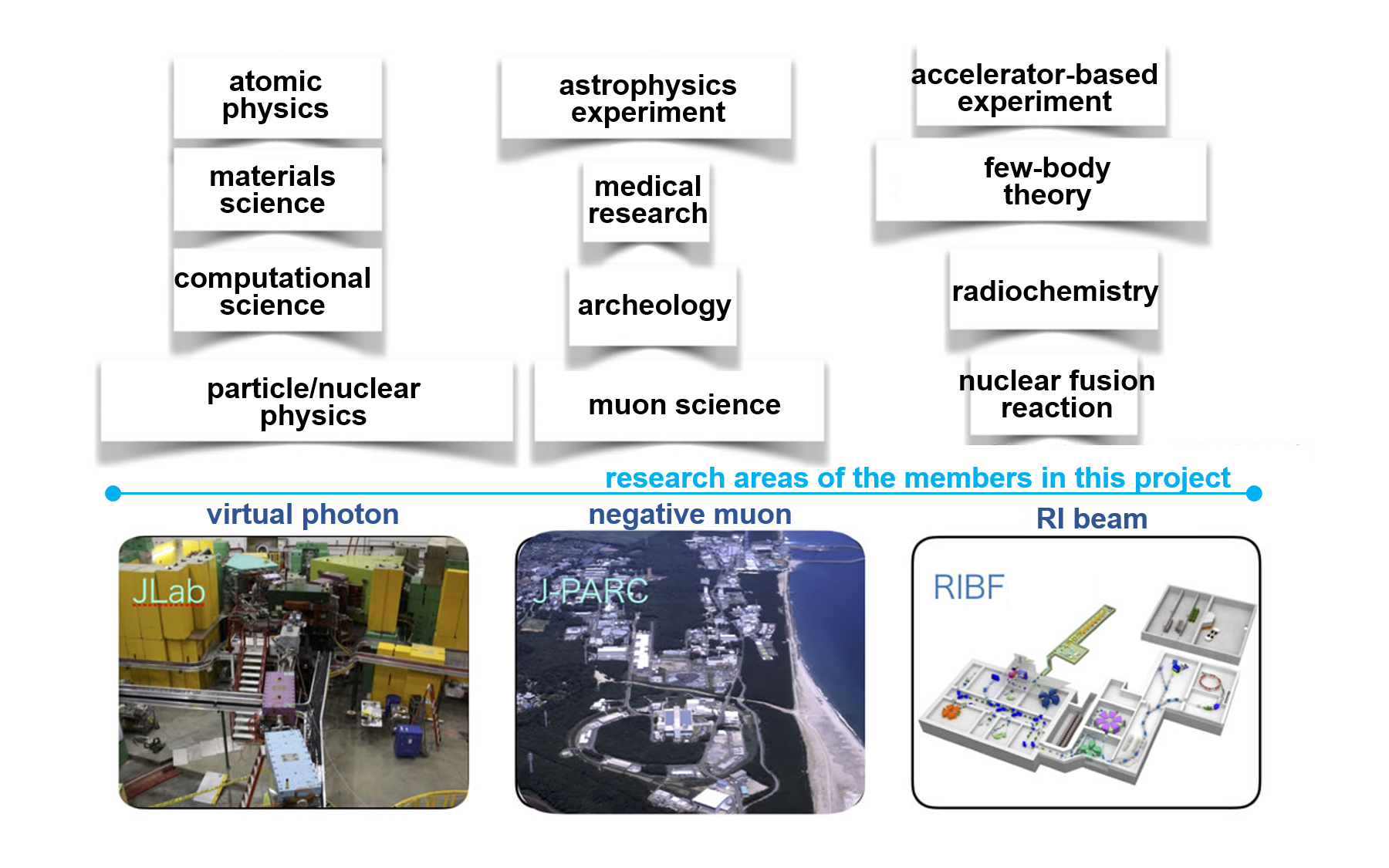Purpose of the Research Project
In recent years, a variety of fundamental scientific research fields have been established due to the production of various high-intensity quantum beams created by accelerators. However, these studies have been carried out independently and not enough effort has been made to share theoretical progresses and technological advances to other research fields. Based on the World-renowned advanced detector technology developed in Japan for space X-ray and gamma-ray observations, we will establish common theoretical frameworks and technological platforms and combine them with exotic quantum beams, namely negative muons, virtual photons and polarized RI beams. This will enable us to perform cooperative works in different research fields and develop novel methods. Furthermore, this will not only contribute to the area of fundamental sciences, but also towards new applications such as non-destructive 3D element analysis and medical applications.
Content of the Research Project
 Relationship between three research fields in this project and the planned-research programs, where publicly-offered research programs will be later added. We aim to create new application areas across the field through all these programs.
We aim to advance X-ray and γ-ray imaging technologies and apply them to different research fields of quantum-beam experiments and to various other applications such as non-destructive analysis and medical imaging.
Relationship between three research fields in this project and the planned-research programs, where publicly-offered research programs will be later added. We aim to create new application areas across the field through all these programs.
We aim to advance X-ray and γ-ray imaging technologies and apply them to different research fields of quantum-beam experiments and to various other applications such as non-destructive analysis and medical imaging.
(1) Precise spectroscopic measurements will be performed by detecting muonic X-rays combined with ultra-high resolution X-ray spectrometer and cadmium telluride (CdTe) semiconductor sensors. In addition, using the common framework of few-body theory combined with precise electro- magnetic spectroscopy of Λ hypernuclei utilizing real and virtual photons, hypernuclei in wide mass region will be studied to clarify the baryonic force and solve the puzzle of heavy neutron stars.
(2) A nondestructive 3D imaging element analysis method will be established using muonic atom characteristic X-rays for bulk samples, and studies will be conducted on extraterrestrial samples and archeology artifacts. Scientific research on muon catalyzed fusion will also be promoted based on a newly proposed reaction using high-intensity negative muon beam. Furthermore, by creating highly polarized RI beam without element dependence and replacing RI with atomic nucleus in a substance, material science research will be advanced by using the ultra-sensitive beta-radiation detected NMR method similar to μSR.
(3) Advanced detector system required for expanding the field as well as ultra-slow negative muon beam development will be carried out. Collaborative research with scientists in medicine and pharmacy will be initiated to develop in vivo 3D γ-ray imaging device for small animals by applying CdTe semiconductor sensors to medical research on cancer stem cells.
Expected Research Achievements and Scientific Significance
 A wide variety of scientific fields in this project
Unprecedented precision experiments with newly developed detectors and exotic quantum beams will be realized in this program. A common theoretical framework of few-body systems will be established based on these experimental results. Especially, a research on exotic atoms using negative muons as "probes" has dramatically progressed, and application of muonic character- ristic X-rays as ultra-sensitive non-destructive element analysis can finally be realized. Highly-sensitive in vivo γ-ray 3D imaging device with CdTe semi-conductor sensor technology will initiate studies of the properties and diversity of cancer cells in a tumor. Gathering researchers from various fields of expertise and generating ideas through brainstorming creates a "platform that facilitates the creation of new concepts".
A wide variety of scientific fields in this project
Unprecedented precision experiments with newly developed detectors and exotic quantum beams will be realized in this program. A common theoretical framework of few-body systems will be established based on these experimental results. Especially, a research on exotic atoms using negative muons as "probes" has dramatically progressed, and application of muonic character- ristic X-rays as ultra-sensitive non-destructive element analysis can finally be realized. Highly-sensitive in vivo γ-ray 3D imaging device with CdTe semi-conductor sensor technology will initiate studies of the properties and diversity of cancer cells in a tumor. Gathering researchers from various fields of expertise and generating ideas through brainstorming creates a "platform that facilitates the creation of new concepts".
